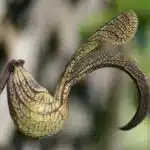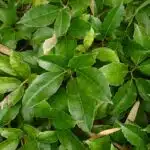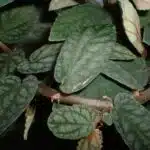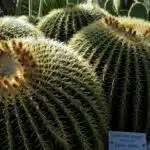The Jade Vine, also known as Strongylodon, is a stunning tropical vine with unique jade-green flowers that hang in clusters. Native to the Philippines and other parts of Southeast Asia, this plant requires warm temperatures and high humidity to thrive. While it is typically grown outdoors in tropical climates, it is possible to cultivate the Jade Vine indoors in cooler regions.
Growing the Jade Vine indoors can be a challenging but rewarding experience for horticulturists and plant enthusiasts alike. This article will provide an overview of the ideal growing conditions for the Jade Vine, including temperature, light, moisture, and soil requirements. Additionally, we will discuss common challenges that may arise when growing this plant indoors and provide tips for overcoming them. By following these guidelines, you can successfully cultivate this exotic beauty in your own home or greenhouse.
Overview Of The Jade Vine
Jade vine, scientifically known as Strongylodon macrobotrys, is a rare and unique climbing plant that belongs to the Leguminosae family. It is native to the rainforests of the Philippines and was first discovered by botanist E.D. Merrill in 1913. The jade vine is known for its stunning turquoise-blue flowers that can grow up to three meters long, making it one of the most striking plants in the world.
The jade vine’s flowers are not only aesthetically pleasing but also have cultural significance in different parts of the world. In the Philippines, where it is commonly found, it is considered a symbol of love and affection. The flowers are often used in traditional Filipino weddings as decorations or worn by brides as part of their bridal attire. In Hawaii, where the plant is also grown, it represents royalty and is referred to as “princess flower.”
Aside from its cultural significance, the jade vine has other practical uses. Its roots contain nitrogen-fixing bacteria that help improve soil fertility, while its leaves can be used for medicinal purposes such as treating skin infections and inflammation. With its stunning beauty and cultural importance, it’s no wonder why many people seek to cultivate this rare plant both indoors and outdoors. In the next section, we will delve into the history and origin of this magnificent plant.
History And Origin Of The Jade Vine
The jade vine, scientifically known as Strongylodon, is a unique and fascinating plant that belongs to the legume family. Originating from the tropical forests of the Philippines, this flowering vine can grow up to 20 meters long and produces clusters of vibrant blue-green flowers that resemble jade. The significance of the jade vine in its native country goes beyond its aesthetic appeal as it is also used for medicinal purposes.
Cultural uses and symbolism associated with the jade vine are prevalent in Philippine folklore. According to legend, the plant was believed to have mystical powers that could ward off evil spirits and bring good luck. Additionally, in traditional medicine, various parts of the plant were used to treat fever, coughs, and other ailments. In modern times, the jade vine has become an important symbol of conservation efforts in the Philippines due to its endangered status.
Growing the jade vine indoors can be challenging but rewarding for horticultural enthusiasts. To create an ideal environment for this plant, it is crucial to consider factors such as temperature, humidity, and lighting conditions. Temperature plays a significant role in determining whether the plant will thrive or not; thus, it is essential to keep it at a consistent level between 18-24°C. Providing adequate lighting through artificial light sources or natural sunlight is also necessary for optimal growth. Another vital factor is humidity levels; misting or using a humidifier can help maintain suitable levels for healthy growth.
Transition: Understanding how cultural beliefs and practices have shaped our perception of plants like the jade vine can give us newfound appreciation for their value beyond mere aesthetics. In exploring ways to cultivate this unique plant indoors successfully, we must also take into account environmental factors such as temperature- which we will delve deeper into in the next section.
Ideal Temperature For Growing The Jade Vine Indoors
The optimal temperature for growing the jade vine indoors is between 18°C to 25°C. This tropical plant thrives in warm and humid conditions, which makes it essential to maintain a consistent temperature. Any drastic changes in temperature can cause the plant to wilt or even die. Therefore, it is crucial to ensure adequate temperature control by placing the plant in a room with a stable temperature and avoiding exposure to drafts.
Jade vines require specific environmental conditions to grow and thrive indoors. The right temperature plays a significant role in ensuring its success as an indoor plant. It is advisable to place the plant away from windows or doors that may expose it to extreme temperatures or fluctuations. In addition, using a thermometer can help monitor the room’s temperature and make any necessary adjustments to maintain optimal conditions.
Temperature control is critical when growing jade vines indoors, as they are susceptible to extreme weather conditions such as frost and heatwaves. Maintaining ideal temperatures helps prevent damage caused by fluctuating temperatures, which can affect the overall health of the plant. Therefore, it is essential to provide proper care by monitoring room temperatures closely while avoiding sudden changes that may harm the jade vine.
To continue providing adequate care for your jade vine, it is essential to understand its light requirements. Adequate lighting is crucial for proper growth and development of this tropical plant species indoors. Let us explore more about how you can provide optimal lighting conditions for your jade vine in the subsequent section on light requirements for this beautiful houseplant species.
Light Requirements For The Jade Vine
Light intensity is an important factor for the successful growth of the Jade Vine, as it requires full to partial sun in order to thrive. The duration of light exposure should also be considered, as the Jade Vine is best suited for 12 – 14 hours of sunlight per day. For those wishing to grow the Jade Vine indoors, it is important to provide artificial lighting sources which are able to match these requirements. Additionally, the positioning of the light sources must also be considered in order to ensure optimal light coverage.
Light Intensity
As a horticulturalist, one of the most important factors in growing the jade vine (Strongylodon) indoors is providing the appropriate light intensity. Low light conditions can be detrimental to its growth and overall health. Therefore, it is essential to ensure that the plant receives sufficient light to thrive.
In low light conditions, artificial lighting can be used to supplement natural sunlight. However, it is important to choose the right type of artificial lighting as not all lights are suitable for plants. Full-spectrum fluorescent bulbs or LED grow lights are excellent choices for indoor gardening. These lights provide a broad spectrum of light that mimics natural sunlight and promotes healthy plant growth.
It is important to note that jade vines require bright but indirect light rather than direct sunlight. Therefore, placing them near a window with filtered light or using sheer curtains can help regulate the amount of light they receive. By following these guidelines and providing adequate lighting, your jade vine will flourish indoors and bring joy and beauty to your home.
Light Duration
Light is a crucial factor in the growth and development of plants, including the jade vine (Strongylodon). As discussed earlier, providing the appropriate light intensity is important for their overall health. However, light duration is another aspect that should be taken into consideration. The amount of time that a jade vine receives light can affect its growth and flowering.
For jade vines grown indoors, artificial lighting can be used to supplement natural sunlight. One of the benefits of using artificial lighting is that it allows growers to control the duration of light exposure. Generally, jade vines require 10-12 hours of light per day during their growing season to promote healthy vegetative growth and flower production. Therefore, it is recommended to provide them with this amount of light exposure consistently.
In addition to light duration, understanding the spectrum requirements of jade vines is also important when using artificial lighting. Full-spectrum fluorescent bulbs or LED grow lights are excellent choices as they provide a broad spectrum of light that mimics natural sunlight. However, it is crucial to ensure that the bulbs used have a balanced spectrum that includes both red and blue wavelengths to promote healthy growth and flowering in jade vines. By providing adequate light duration and choosing the right type of artificial lighting, indoor gardeners can ensure optimal growth and beauty from their jade vines.
Moisture And Humidity Needs Of The Jade Vine
As mentioned in the previous section, proper lighting is crucial in growing a jade vine indoors. However, it is equally important to ensure that the plant receives appropriate moisture and humidity levels. In this section, we will discuss the watering frequency and humidity control techniques necessary for successfully growing a jade vine indoors.
Watering frequency plays a significant role in maintaining the health of your jade vine. Overwatering can lead to root rot, which can be detrimental to its growth. On the other hand, underwatering can cause wilting and yellowing of leaves. A good rule of thumb is to water your jade vine when the top layer of soil feels dry to the touch. It’s best to water deeply until it drains out from the bottom of the pot, ensuring that all roots receive adequate moisture.
Controlling indoor humidity can also impact your jade vine’s health. Misting techniques or using a humidity tray are two effective ways of increasing humidity levels around your plant. Misting involves spraying water on your plant’s foliage regularly, while a humidity tray involves placing a layer of pebbles or stones at the bottom of a tray filled with water beneath your plant’s pot. As water evaporates from the tray, it raises humidity levels around your plant. Maintaining an optimal level of 50-60% relative humidity is ideal for healthy growth.
Next, let’s discuss soil requirements for growing a jade vine indoors.
Soil Requirements For The Jade Vine
The soil requirements for the Jade Vine are quite specific, and it is important to choose the right soil mixture to ensure that your plant thrives. One of the most important considerations when choosing soil for your Jade Vine is improving drainage. The roots of the Jade Vine are very sensitive to water saturation, so it is essential that you choose a soil mixture that allows excess water to drain away quickly.
To improve drainage in your soil mixture, consider adding materials such as perlite or coarse sand. These materials will help to create air pockets within the soil, allowing excess water to move through more easily. It’s also important to avoid using heavy soils like clay, which can hold onto water for too long and lead to root rot.
Choosing the right pot size is another key factor in ensuring that your Jade Vine thrives. A pot that is too small can restrict root growth and limit the amount of nutrients available to your plant. Similarly, a pot that is too large can cause problems by holding onto excess moisture and potentially leading to root rot. Ideally, you should choose a pot size that allows room for your plant’s roots to grow while still providing good drainage and airflow.
With the right soil mixture and pot size, you can create an ideal environment for your Jade Vine to thrive. In the next section, we’ll discuss how to choose the right container for your plant, taking into account factors like material, shape, and size. By following these guidelines and caring for your plant properly, you can enjoy beautiful blooms from your Jade Vine year after year.
Choosing The Right Container For Your Jade Vine
After discussing the soil requirements for growing jade vines indoors, the next important factor to consider is choosing the right container. The container material plays a vital role in providing an optimum environment for plant growth. It should be sturdy and durable enough to support the vine’s weight and withstand moisture without breaking down. Terracotta pots are a popular choice as they are porous and allow for air circulation, but they can dry out quickly, requiring more frequent watering.
Another crucial aspect of selecting a container is ensuring that it has adequate drainage holes. Proper drainage is essential as it prevents water from accumulating at the bottom of the pot and causing root rot. Without draining holes, excess water can lead to oxygen starvation, which can ultimately kill your plant. Therefore, when selecting a container for your jade vine, ensure that it has enough drainage holes and that they are large enough to allow water to escape freely.
To ensure optimal growth of your jade vine indoors, you need to select the right container material and ensure proper drainage. Some additional tips include avoiding containers with saucers or trays beneath them as these can trap excess water leading to root rot. In addition, always make sure that there is a layer of gravel or small rocks at the bottom of your pot before adding soil; this helps improve drainage by allowing water to flow freely through the potting mix. With these considerations in mind, you’ll have a healthy jade vine thriving in no time!
Moving forward towards fertilizing your jade vine indoors requires careful consideration of several factors.
Fertilizing Your Jade Vine
Jade vines require regular fertilization to maintain their vibrant green foliage and promote healthy growth. Gardeners have two choices when it comes to choosing fertilizers for their jade vines: organic or synthetic. Organic fertilizers are made from natural materials, such as compost, manure, and bone meal. Synthetic fertilizers, on the other hand, are chemically engineered to provide specific nutrients to plants.
When deciding which type of fertilizer to use on your jade vine, consider the benefits of each. Organic fertilizers are environmentally friendly and promote healthy soil by adding beneficial microorganisms. They release nutrients slowly over time, providing a steady supply of food for your plant. Synthetic fertilizers are formulated to meet specific nutrient requirements and can provide quick results. However, they can be harmful if not used correctly and can damage soil quality over time.
The best time to fertilize your jade vine is during its active growing season in spring and summer. Apply the fertilizer once every two weeks using a balanced formula with equal amounts of nitrogen, phosphorus, and potassium (NPK). Be careful not to over-fertilize your plant as this can lead to root burn or damage. Always follow the manufacturer’s instructions when applying fertilizer and water your plant thoroughly after application.
Pruning And Training Your Jade Vine
Pruning techniques play a vital role in maintaining the overall health and growth of your jade vine. The best time to prune is during the winter or early spring when the plant enters into a dormant phase. During this period, cut back any dead stems, damaged leaves, or branches that are growing in the wrong direction. Use clean pruning shears to prevent any disease transmission.
Jade vines can grow up to 75 feet long in their natural habitat, so training methods are essential for indoor cultivation. You can use stakes or trellises to support your jade vine’s growth and direct it towards your desired location. When using stakes, place them near the base of the plant and loosely tie the stem to avoid damage. Alternatively, you can train your vine around a trellis by gently wrapping its tendrils around it.
In summary, proper pruning techniques and training methods are crucial for maintaining a healthy and aesthetically pleasing jade vine indoors. By pruning during its dormant phase and using supportive structures for training, you can enjoy a stunning display of foliage year-round. However, even with these practices in place, pests and diseases can still occur, which we will discuss further in the following section.
Common Pests And Diseases Of The Jade Vine
After pruning and training your jade vine, it is important to maintain its health by preventing infestations and identifying symptoms of diseases. A common pest that affects jade vines is spider mites, which can cause discoloration and webbing on the leaves. These pests are often found in dry environments, so keeping the humidity level high can help prevent their infestation. Additionally, you can use insecticidal soap or neem oil to treat them.
Another common issue for jade vines is fungal diseases such as powdery mildew or root rot. Symptoms include white powdery patches on the leaves or yellowing and wilting of the plant. To prevent these issues, avoid overwatering your jade vine and make sure it has good drainage. If you notice any symptoms, remove the affected parts of the plant and treat with a fungicide.
It is crucial to regularly inspect your jade vine for signs of pests or diseases to prevent them from spreading and causing damage to your plant. By maintaining optimal growing conditions such as proper watering, adequate sunlight, and appropriate temperatures, you can also boost your plant’s natural defenses against pests and diseases. In the next section, we will discuss how to prevent and treat pest and disease issues for your jade vine using organic methods that are safe for both you and your plant.
How To Prevent And Treat Pest And Disease Issues
Preventative measures are the most effective way to keep pest and disease issues at bay. First and foremost, ensure that your jade vine receives adequate light, water, and nutrients. A healthy plant has a stronger immune system and is better equipped to fight off any potential invaders. Additionally, maintain cleanliness in your growing environment by removing fallen leaves or debris that could harbor pests or diseases.
In the event that pest or disease issues do arise, there are natural remedies that can be used as a first line of defense. For example, neem oil is an organic insecticide that can be used to treat common pests such as spider mites or aphids. Alternatively, a solution of water and dish soap can work as a mild insecticide for smaller infestations. For fungal diseases such as powdery mildew, a mixture of baking soda and water can be applied to affected areas.
It’s important to note that prevention is always preferable over treatment. Regularly inspect your jade vine for any signs of pests or diseases and take action immediately if anything is detected. By following these preventative measures and utilizing natural remedies when necessary, you can maintain a healthy growing environment for your jade vine.
As you become more experienced with growing jade vines indoors, you may wish to propagate your plant through cuttings or division. This allows you to create new plants while also renewing the health of the parent plant. In the next section, we will discuss how to propagate your jade vine using these methods.
Propagating Your Jade Vine
Preventing and treating pest and disease issues is crucial in growing healthy jade vines indoors. However, with proper care and attention, propagation of these plants can be a rewarding experience for any plant enthusiast. The best propagation methods to use are softwood cuttings or layering.
Softwood cuttings are taken from the tips of the vine during the growing season. Select a stem that is free from any signs of disease or pests, cut it at an angle just below a node, and remove all but two to three leaves at the top. Dip the cutting in rooting hormone powder and plant it in well-draining potting soil. Keep it moist and warm until roots develop.
Layering involves bending a healthy stem down to the soil surface, creating small cuts in the stem’s bark where it will come into contact with soil. Cover this section with soil or sphagnum moss, keeping it moist until roots begin to form. Once roots have formed, sever the stem from its parent plant and transplant into a new container or planting bed.
Table: Comparison of Softwood Cuttings vs Layering as Propagation Methods
| Softwood Cuttings | Layering | |
|---|---|---|
| Time | Takes less time | Takes longer |
| Success Rate | High success rate | Moderate success rate |
| Maintenance | Requires more attention | Less maintenance needed |
In propagating your jade vine, take note that each method has its advantages and disadvantages. Choose which technique works best for you based on your resources and preferences. With proper care, patience, and dedication, you can successfully propagate your jade vine at home without any hassle! Next up we will discuss transplanting your jade vine to ensure its continued growth and development.
Transplanting Your Jade Vine
Transplanting Your Jade Vine is an essential step in its growth and maintenance. It provides numerous benefits such as giving the plant more space for root development, fresh soil, and nutrients. Transplanting also helps to prevent the plant from becoming root-bound, which can cause stunted growth and other issues.
The Best Time to Transplant your Jade Vine is during the spring or early summer when the plant is actively growing. This is because transplanting during this period ensures that the plant has enough time to establish its roots before winter arrives. When transplanting, it’s crucial to choose a pot that’s one size larger than the current pot and fill it with fresh soil that has good drainage.
To ensure a successful transplant, there are some important things you should keep in mind. Firstly, water your jade vine a few days before transplanting it to make sure it’s well hydrated. Secondly, gently loosen the roots from the old soil before planting it in a new pot with fresh soil. Finally, add compost or other organic matter to improve soil fertility and promote healthy growth.
Moving forward into our next section on troubleshooting common issues when growing jade vine indoors; proper transplantation practices will help prevent many of these problems from occurring so be sure to follow these guidelines carefully!
Troubleshooting Common Issues When Growing Jade Vine Indoors
The Jade Vine requires regular, consistent watering, as too much or too little can cause the plant to become weak or diseased. Adequate sunlight is also essential for successful growth, with the ideal spot being a well-lit, south-facing window. Pests can be a common issue when growing Jade Vine indoors, and should be monitored and addressed with appropriate insecticides or natural remedies if necessary. Overwatering should be avoided as it can lead to root rot or other fungal issues. An appropriate amount of fertilizer should be used to ensure adequate nutrition and health. Pruning should be done to encourage healthy branching and growth, and to ensure the Jade Vine is not too large for the space it is being grown in.
Watering
Watering is a crucial aspect of growing the jade vine indoors. This plant requires consistent moisture to thrive, but overwatering can lead to root rot and ultimately kill the plant. It is important to establish a regular watering schedule while also monitoring the soil moisture levels to avoid any potential issues.
The frequency of watering will depend on various factors such as temperature, humidity, and light exposure. Generally, it is recommended to water the jade vine when the top inch of soil feels dry to the touch. However, it is essential not to let the plant completely dry out between waterings. The best approach is to check the soil moisture regularly and adjust watering frequency accordingly.
In addition to watering frequency, proper watering technique is also crucial for growing a healthy jade vine indoors. Water should be applied directly to the soil rather than onto the leaves or flowers. It is also essential not to leave excess water in the saucer beneath the pot, as this can lead to root rot. By following these guidelines for watering, you can ensure that your jade vine thrives and remains healthy in its indoor environment.
Light
As a horticulturalist, it is essential to understand the role of light in growing a healthy jade vine indoors. Adequate lighting is crucial for plant growth and development, and insufficient light can lead to various issues such as stunted growth and poor flowering. When growing jade vines indoors, natural light may not always be sufficient, especially during the winter months or in areas with limited sunlight. In such cases, artificial light can be used to supplement the plant’s lighting needs.
Artificial light can be an effective way to provide additional lighting for indoor plants such as the jade vine. LED grow lights are a popular choice among indoor gardeners due to their energy efficiency and ability to mimic natural sunlight. When using artificial light, it is important to consider both the intensity and duration of light exposure. Jade vines require bright but indirect light for at least six hours per day. Therefore, it is recommended to place the grow lights approximately 12 inches above the plant and maintain a consistent daily schedule of six hours of artificial light exposure.
In addition to providing adequate lighting, monitoring the duration of light exposure is also crucial when growing jade vines indoors. Too much or too little exposure can negatively impact plant growth and development. Overexposure to artificial or natural light can cause leaf burn or drying out of leaves while underexposure can lead to stunted growth or poor flowering. Thus, it is important to establish a consistent schedule for both natural and artificial lighting that meets the specific needs of your jade vine based on its location and surrounding environment.
Pests
As a horticulturalist, growing jade vines indoors can be challenging, especially when it comes to pest management. Pests such as spider mites, mealybugs, and scale insects can cause significant damage to the plant if left unchecked. Therefore, it is important to be vigilant and proactive in identifying and addressing any pest issues that may arise.
One effective way of managing pests on your jade vine is through the use of natural remedies. Natural remedies such as neem oil or insecticidal soap can be effective in controlling common pests without harming the plant or the environment. These remedies work by suffocating or disrupting the pests’ life cycle, preventing them from reproducing and causing further damage. However, it is important to note that even natural remedies can have negative effects if not used correctly, so always follow the instructions carefully.
If natural remedies do not work, chemical control options may be necessary. However, it is crucial to exercise caution when using chemicals as they can harm both the plant and the environment if not used correctly. Always read labels carefully and follow instructions closely when applying pesticides. It is also recommended to avoid using broad-spectrum pesticides that can kill beneficial insects along with pests. Instead, choose targeted pesticides that only affect specific pests while sparing other organisms in the environment.
In conclusion, managing pests is an essential aspect of growing a healthy jade vine indoors. Natural remedies are an effective first line of defense against common pests while chemical control should only be considered as a last resort. By being proactive and taking preventative measures such as regularly inspecting your plants for signs of infestation and maintaining good hygiene practices, you can help keep your jade vine healthy and free from pest-related issues.
Conclusion And Final Thoughts
As we reach the end of our discussion on growing jade vine indoors, it’s quite ironic that we’ve come full circle. We started by discussing how difficult it is to cultivate this plant in the wild, and now we’re talking about how easy it is to grow it indoors. The benefits of growing jade vine indoors are numerous. Not only does it add a unique touch to your interior décor, but it also helps purify the air around you.
When compared to other indoor vines, jade vine stands out for its vibrant blue-green color and unusual flowers. Most indoor vines are grown for their foliage rather than their blooms, but jade vine offers both. It’s a low-maintenance plant that doesn’t require frequent watering or pruning, making it an ideal choice for those who want a beautiful yet hassle-free addition to their home.
In summary, growing jade vine indoors is an excellent way to add beauty and clean air to your living space. Its unique color and blooms make it stand out from other indoor vines while its low-maintenance nature makes it easy to care for. Whether you’re a seasoned horticulturist or just starting out in the world of plants, adding a jade vine to your collection is always a good idea.
Conclusion
The jade vine, also known as Strongylodon macrobotrys, is a stunning tropical plant that can brighten up any indoor space. With its unique blue-green flowers and cascading vines, the jade vine is sure to be a conversation starter. While it may seem like a difficult plant to grow, with the right care and attention, anyone can successfully cultivate this beauty indoors.
To ensure optimal growth of your jade vine, it is important to understand its ideal temperature range, light requirements, and moisture needs. This plant thrives in warm temperatures between 65-80°F and requires bright but indirect sunlight. Additionally, keeping the soil moist but not waterlogged and maintaining high humidity levels will help your jade vine flourish.
Propagation of the jade vine can be done through stem cuttings or by seed. Transplanting your jade vine should be done carefully to avoid damaging its delicate root system. Common issues when growing this plant include spider mites and root rot which can be prevented by proper care and maintenance.
In conclusion, the jade vine is a magnificent addition to any indoor garden with its vibrant colors and unique appearance. By providing adequate warmth, light, moisture, and propagating with care, you too can enjoy this beautiful plant in your home. With diligence and patience, you will soon find yourself rewarded with a flourishing jade vine that will bring joy for years to come!
Image Credits
- “Jade vine in the Princess of Wales Conservatory” by Kew on Flickr (featured)











![How To Grow And Care For Corkscrew Vine 16 Strophanthus preussii [Corkscrew Flower, Poison Arrow Vine, Spider Tresses, Tassel Vine] Apocynaceae](https://green-life.blog/wp-content/uploads/2023/04/KW5aFOG5S3jq-150x150.jpg.webp)

















